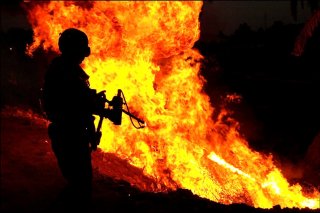Why the Military (Reluctantly) Gave Up on Flamethrowers
The idea of using fire as a weapon likely occurred as soon as the first human settlement was attacked by a rival tribe.
Here's What You Need to Remember: In Vietnam, various flamethrowers were also seen as a valuable close combat weapon—one that could demoralize enemy troops and reduce positions that have otherwise resisted other forms of attack.
The idea of using fire as a weapon likely occurred as soon as the first human settlement was attacked by a rival tribe. The problem is that fire doesn’t know friend from foe and for eons couldn’t really be controlled. The earliest known example of a “controlled burn” directed at an enemy was the Bzyantine’s “Greek Fire.”
Exactly what ingredients went into the mixture and how it was projected at an enemy remains a mystery, but it was certainly a heated, pressurized liquid that was delivered by a tube called a siphōn but it could also be used with hand-held projectors as well as in early grenades. It was mostly used to light enemy ships on fire from a reasonably safe distance. According to various sources Greek Fire was invented in the 7th century and helped the Byzantines fend off early Muslim assaults.
Why it fell out of use is unknown, but by the 13th century, Greek Fire disappeared from the battlefield.
It wasn’t until the First World War that fire was once again harnessed in a controlled manner. German scientist Richard Fiedler had developed the concept of the “Flammenwerfer” in the years just prior to the conflict, and his design was small enough that it could be carried by one man and shot a stream of flaming oil about 20 yards.
The trenches of the Western Front happened to be an ideal proving ground for the then-untested weapon, and the Germans first employed both the compact version as well as a larger version that doubled the range against French troops outside of Verdun in early 1915. The weapons were once again used against the British in the summer of 1915 and this convinced the Germans to deploy the Flammenwerfer across all the fronts.
After the end of the war other nations considered how the flamethrower could be employed, and both the Americans and British developed new models that were fueled with napalm, a thickened gasoline that burned with intense heat. The U.S. military used these to great effect against the Japanese fortifications including log bunkers and caves during World War II.
The biggest disadvantage of the flamethrower was that a soldier had to wear a heavy tank on his back, which restricted movement and made that individual a very large target. While the fuel might not ignite from being hit by an enemy round, the escaping gas, once mixed with oxygen, would be quite flammable! The other issue was that flamethrowers really only offered about twenty to thirty seconds of use—after which it was just a heavy piece of equipment to carry.
Despite these issues, the U.S. Department of Defense clearly saw some potential advantages that the flamethrower offered and created various man-portable and vehicle-mounted incendiary weapons. This included the M-202 Flame Assault Shoulder Weapon (FLASH), which was a rocket-based system that could hit a target five times further away than the older World War II-era devices.
In Vietnam, various flamethrowers were also seen as a valuable close combat weapon—one that could demoralize enemy troops and reduce positions that have otherwise resisted other forms of attack. However, images of the “Napalm Girl”—the 1972 Pulitzer Prize-winning photo of a naked nine-year-old girl fleeing her village following a napalm attack—helped turn public opinion against the use of such weapons.
There are no specific international bans on the use of flamethrowers; however, there are the international humanitarian law (IHL) treaty norms, which specifically regulate incendiary weapons as found in the 1980 Protocol III on Prohibitions or Restrictions on the Use of Incendiary Weapons to the Convention on Prohibitions or Restrictions on the Use of Certain Conventional Weapons (Protocol III). This would include, “any weapon or munitions which is primarily designed to set fire to objects or to cause burn injury to persons through the action of flame, heat, or combination thereof, produced by a chemical reaction of a substance delivered on the target (emphasis added).”
Whether this would call for a ban on such weapons is unclear according to legal experts: “It is uncontroversial that any use of a flamethrower, be it a proper incendiary weapon or not, in breach of those rules on the protection of civilians would be unlawful. The same would hold true for any weapon.”
However, in 1978 the DoD issued a directive effectively retiring flamethrowers from use in combat.
Perhaps ironically, while automatic weapons including machine guns, as well as short-barreled rifles/shotguns and other destructive devices, now all fall under the National Firearms Act of 1934, flamethrowers do not. Various commercial versions that can still shoot fire up to fifty feet are completely legal in 48 states; only Maryland bans them outright, while California considers them “destructive devices,” but does issue permits for restricted use such on movies.
Peter Suciu is a Michigan-based writer who has contributed to more than four dozen magazines, newspapers and website. He is the author of several books on military headgear including A Gallery of Military Headdress, which is available on Amazon.com.
This first appeared last year and is being republished due to reader interest.
Image: Flickr.

